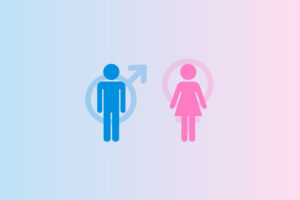Not long ago, people used both sex and gender to describe the reality that human beings are biologically male and female. But today, these words mean different things. They are now used to distinguish between biological function and social function. While sex refers to the biological reality of being male or female (defined by chromosomes and various primary and secondary sex characteristics), language has shifted so that gender now refers to perceived psychological, social, and cultural aspects of being male or female.
Despite the cultural change, gender differences remain rooted in sex differences. While there remains great diversity within men as a group or women as a group, biological differences do contribute to psychological and personality differences between men and women on average. These differences contribute to different levels of interest and participation in certain occupations, sports, and recreational activities. Such differences are natural, not nefarious. In progressive countries with policies promoting sexual equality and with many career paths open to both sexes, differences in men’s and women’s occupational preferences often become more, not less, pronounced.
That is not to say that all cultural expectations related to gender or all differences of participation in certain occupations or activities are right or fair. But accepting and appreciating that there is a natural connection between sex differences and gender differences is essential for preserving mental and emotional well-being. Gender differences are not inherently bad. We should be careful about trying to eliminate any and all gender differences to create uni-sex or uni-gender human beings. Like uni-corns, they don’t and, more fundamentally, can’t exist.
“Accepting and appreciating that there is a natural connection between sex differences and gender differences is essential for preserving mental and emotional well-being.”
We should also be careful not to strictly enforce assumed gender differences, which may artificially limit people in developing their gifts and interests. Telling a boy who enjoys activities typically associated with the opposite sex that he should not do those things because he is a boy may cause him needless distress and confusion about his identity.
Early feminists rightly highlighted both the differences between and the fundamental equality of men and women. Treatises by early modern feminists spoke of the equality of the sexes (rather than genders) in their writing (see, for example, Simone De Beauvoir, The Second Sex, 1949.) However, the focus of gender discussions is now gender identity, a concept that overrides and even erases sex.

(Photograph by Andrea Piacquadio / Pexels.com)
Gender identity is a relatively new concept. It is not the same as gender. Whereas gender refers to the social and cultural aspects of being male or female, gender identity refers to one’s internal, subjective sense of being male or female. Thus, in the past, a boy who wore a dress and make-up to look like a girl might have been called a “boy presenting as a girl.” But today, a boy who believes he is “truly” a girl but who does not try to appear to be female would still be considered a girl presenting as a boy.
Gender expression is another new term. It refers to the way in which a person attempts to express his or her gender identity through clothing, cosmetics, and mannerisms. Ironically, this expression usually depends on gender stereotypes or social constructs (e.g. that pink is a feminine colour or that short hair is a masculine feature).
“Biological sex, gender, and gender identity are all connected, not separate.”
Gender ideology today claims that a person’s “true” identity as male or female (or both, neither, or somewhere in between) depends on his or her self-conception, not on his or her biological body. People rarely ask what it means, for example, for a boy to “feel” or “know” he is girl. He might desire to be girl, or imagine what it would be like to girl, or even mistakenly believe he really is girl. But none of these would make him a girl. The explanation given when it comes to identifying young children as transgender is often shockingly shallow, such as noting that a boy prefers (stereotypically) feminine toys, colours, and clothes.
Biological sex, gender, and gender identity are all connected, not separate. They are not like Lego pieces that can be assembled in an infinite combination of patterns. They are more like the roots, the trunk, and the leaves of a tree that are organically connected to each other and support one another. That is the way that human beings best flourish, and the reason we advocate against cultural efforts to break sex, gender, and gender identity apart.
